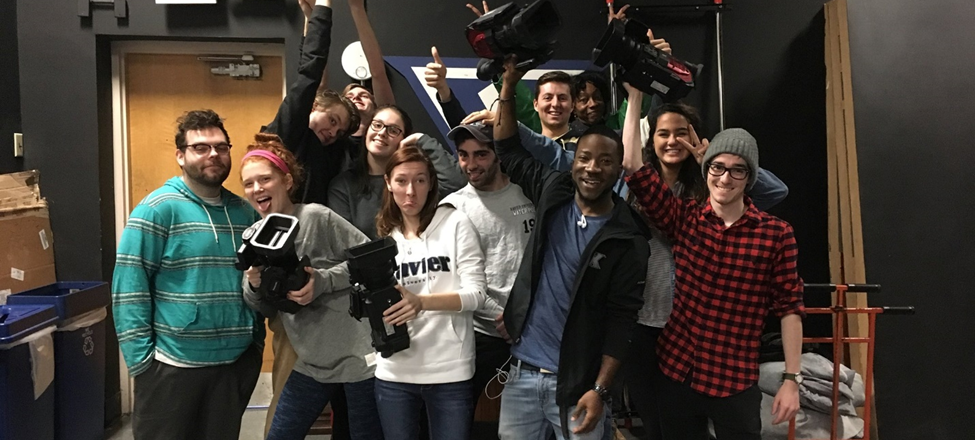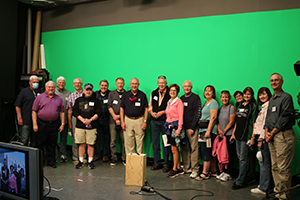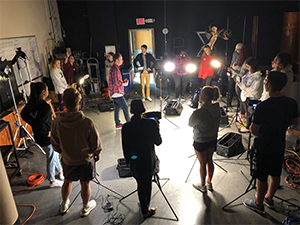
50 Years of Electronic Media at Xavier
Mar 3, 2023
In the interim, DeVault welcomes the support from alumni through the TEDI endowment. It was Mike Cutler who got it started during their reunion a year ago. The group took a tour of the TV studio and met some of the students and afterward, Cutler handed her a check for $5,000.
“I said, ‘This is for your students,’” Cutler said. “I wasn’t thinking of anything more than that, but a couple of my other comrades said we ought to do more and maybe start an endowment and see if we can raise enough so DIFT has a lifeline for growth and developing technologies.”
Their core alumni group, including Cutler, Adrick, Larry Holt and Tom Stevens, Class of 1973, and Russ Read, Class of 1975, met with the Office of University Relations to set up the endowment with their initial contribution of $30,000. They’re now asking alumni to contribute toward a goal of $100,000, which would eventually provide enough interest to support the program financially. The endowment has already grown to over $60,000, Adrick said.

Cutler is excited about the possibilities the endowment could offer the DIFT program. So much has changed since he was a student learning about analog television and broadcast news. He remembers when Adrick moved the studio into Brockman.
“It was literally just a big room which became the studio and a control room built in the corner. We had none of this field equipment, just a big honking TV studio camera,” he said. “It was a monster camera, there were three of them, black and white, and Jay was always tweaking them to get them to work. It was just incredibly primitive.”
But the needs of the program have changed along with the technology that drives the film and television broadcast industries. It was still an analog world when DeVault arrived in 2008, and she oversaw the transition to digital including the purchase of the first digital camera for the program, then called Electronic Media. What was once put on tape is now recorded digitally. Cameras are smaller, more maneuverable and computer-based.

Now as the industry prepares for the next generation of high-definition video, DeVault and her team are challenged to keep up so her students are prepared. Cutler hopes the endowment helps the program stay at the forefront of developing technologies.
“I don’t know what type of computer programs one will need to digitally edit, but the field is expanding so quickly, and we can’t wait to see what is needed to ensure Xavier is a player in the field,” he said. “We need to be sure Xavier is on the leading edge of technology and that Xavier students graduate with the ability to tackle whatever job they envision.”
Adrick said the University also should recognize that video is now ubiquitous. It’s not just TV and movies anymore, and that makes a college-level digital media program that much more relevant.
“We live in a world where video touches everything,” Adrick said. “You go into an operating room in a hospital and video is used there. I don’t care if it’s business, education, health care, you name it, video is everywhere. It has become a universal means of communication, and any of our students going out into the business world are going to find themselves using video. So it’s important that Xavier recognize that and offer a competitive experience in that video world.”
Read more about the history of the DIFT program at Xavier in part one.
-
1963 - First radio station at Xavier in Alter Hall
-
1965 - Xavier upgrades Communication Arts from a minor to a major
-
1968 - First TV studio at old WCPO Symmes Street studio off campus
-
1970 - Radio station on campus becomes WXVU
-
1971 - Jay Adrick returns as Director of Radio and Television and Communication Arts Instructor
-
1973 - TV Center moves to Brockman Hall on campus
-
2008 - Blis DeVault becomes director of the program which is renamed Digital Innovation,Film and Television (DIFT)
-
2021 - Jay Adrick and fellow alumni return for a reunion and create the Endowment for Digital Innovation to support DIFT program.